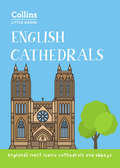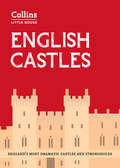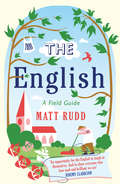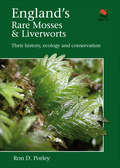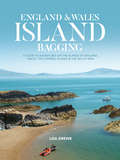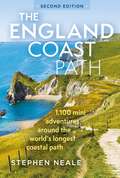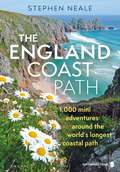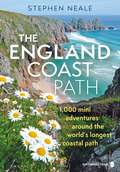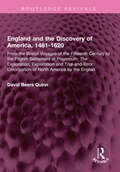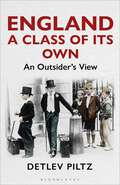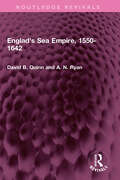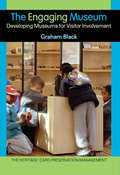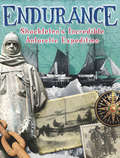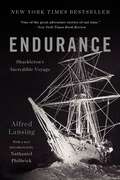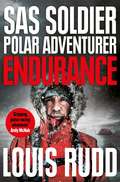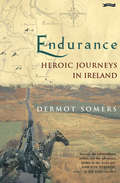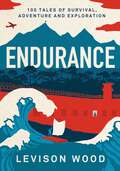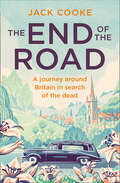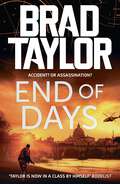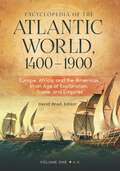- Table View
- List View
English Cathedrals: England’s magnificent cathedrals and abbeys (Collins Little Books)
by Historic UKA handy guide to England’s most famous cathedrals and abbeys. Includes an eight-page map section showing the locations of cathedrals covered in the book.
English Castles: England’s most dramatic castles and strongholds (Collins Little Books)
by Historic UKA handy guide to England’s most dramatic castles and strongholds, many of which are open to visitors. Includes an eight-page map section showing the locations of castles covered in the book.
The English: A Field Guide
by Matt RuddA hilarious field guide to the world’s most remarkable and unusual creatures: the English.
England’s Rare Mosses and Liverworts: Their History, Ecology, and Conservation
by Ron D. PorleyThis is the first book to cover England's rare and threatened mosses and liverworts, collectively known as bryophytes. As a group, they are the most ancient land plants and occupy a unique position in the colonization of the Earth by plant life. However, many are at risk from habitat loss, pollution, climate change, and other factors. Britain is one of the world's best bryologically recorded areas, yet its mosses and liverworts are not well known outside a small band of experts. This has meant that conservation action has tended to lag behind that of more charismatic groups such as birds and mammals. Of the 916 different types of bryophyte in England, 87 are on the British Red List and are regarded as threatened under the strict criteria of the International Union for the Conservation of Nature. This book aims to raise awareness by providing stunning photographs--many never before published--of each threatened species, as well as up-to-date profiles of 84 of them, including status, distribution, history, and conservation measures. The book looks at what bryophytes are, why they are important and useful, and what makes them rare; it also examines threats, extinctions, ex situ conservation techniques, legislation, and the impact of the 1992 Convention on Biological Diversity. Provides the first treatment of England's rare and threatened mosses and liverworts Features stunning photographs--many never before published--of each species and many of their habitats Treats each species in a handy and attractive double-page layout Includes up-to-date profiles of 84 species, including status, distribution, history, and conservation measures Presents the first overview of English bryophyte conservation Offers invaluable guidance to people working in conservation in England, the British Isles, Europe, and beyond
England & Wales Island Bagging: A guide to adventures on the islands of England, Wales, the Channel Islands & the Isle of Man
by Lisa DreweEngland & Wales Island Bagging by Lisa Drewe is a stunning and informative guide to the islands of England, Wales, the Channel Islands and the Isle of Man. It is ideal for swimmers, kayakers, adventure travellers, wildlife spotters and ice cream connoisseurs.Go on an inspirational and fascinating coastline journey – familiar islands are visited, such as Lundy and the Isle of Wight; others are less well known, such as Gewni in Pembrokeshire and Coquet Island in Northumberland. Almost 300 islands are included, from larger, populated islands to remote, uninhabited islets – some can be reached by foot at low tide, others have ferry services, and some you will need your own transport, or be content to view them from the mainland.Once you’ve found your island this book introduces you to the best sites on the island to appreciate: hidden beaches and coves, the tastiest local food and the wildlife that can be seen in the locality. Watch the Cemlyn Bay terns on Anglesey, go paddleboarding around Mersea Island in Essex, walk in the footsteps of pilgrims on Lindisfarne in Northumberland, or enjoy ice cream from one of the smallest dairy herds in the country on St Agnes in the Isles of Scilly … it’s all there to be enjoyed in England & Wales Island Bagging.
The England Coast Path 2nd edition: 1,100 Mini Adventures Around the World's Longest Coastal Path
by Stephen NealeThe definitive guidebook to the entire 3,000-mile length of the new England Coast Path. For anyone planning a trip to the coast or a UK summer holiday, the new England Coast Path national trail is a hugely exciting prospect, and this guidebook shows you how to make the most of every single glorious mile. Environmentalists, volunteers, campaigners, land owners and politicians all came together to create this 'ninth wonder of the world', and from the opening of the path in 2020 onwards, anyone has been able to walk and wild camp along the entire 3,000-mile length of the English coast. It's a fantastic opportunity for all walkers, campers, fans of the coast and the outdoors. Stephen Neale has spent many happy months walking, camping and surveying the path, and from that experience has written a fantastically detailed and rich guidebook covering the route itself, along with everything from the best places to swim, hunt for fossils and eat seafood to hidden away beaches and canoeing spots. Fully updated for its second edition, with 100 extra adventures from the newly opened sections of the path and spectacular new aerial photography, the book is divided up into the 16 coastal counties and features 1,100 places to see, camp and explore around the coast. Each place has map coordinates and basic directions from the path, allowing walkers to either visit specific places or link highlights together, walking between them along the path.The England Coast Path represents what makes England so great: a little bit mad, a little bit proud, and the lucky host to one of the most spectacular and wild coastlines in the world. With this book you too can join the adventure.
The England Coast Path 2nd edition: 1,100 Mini Adventures Around the World's Longest Coastal Path
by Stephen NealeThe definitive guidebook to the entire 3,000-mile length of the new England Coast Path. For anyone planning a trip to the coast or a UK summer holiday, the new England Coast Path national trail is a hugely exciting prospect, and this guidebook shows you how to make the most of every single glorious mile. Environmentalists, volunteers, campaigners, land owners and politicians all came together to create this 'ninth wonder of the world', and from the opening of the path in 2020 onwards, anyone has been able to walk and wild camp along the entire 3,000-mile length of the English coast. It's a fantastic opportunity for all walkers, campers, fans of the coast and the outdoors. Stephen Neale has spent many happy months walking, camping and surveying the path, and from that experience has written a fantastically detailed and rich guidebook covering the route itself, along with everything from the best places to swim, hunt for fossils and eat seafood to hidden away beaches and canoeing spots. Fully updated for its second edition, with 100 extra adventures from the newly opened sections of the path and spectacular new aerial photography, the book is divided up into the 16 coastal counties and features 1,100 places to see, camp and explore around the coast. Each place has map coordinates and basic directions from the path, allowing walkers to either visit specific places or link highlights together, walking between them along the path.The England Coast Path represents what makes England so great: a little bit mad, a little bit proud, and the lucky host to one of the most spectacular and wild coastlines in the world. With this book you too can join the adventure.
The England Coast Path: 1,000 Mini Adventures Around the World's Longest Coastal Path
by Stephen NealeThe opening of the England Coast Path means that anyone will be able to walk and wild camp along the entire 3,000-mile length of the English coast. As well as being a remarkable national achievement in itself, this new national trail is a hugely exciting prospect for all walkers, campers, fans of the coast and the outdoors. In 2018 Stephen Neale became one of the first people to walk and wild camp along the whole of the path, and in doing so has written a fantastically detailed and rich guidebook covering the route itself, along with everything from the best places to swim, hunt for fossils and eat seafood to hidden away beaches and canoeing spots. The bulk of the book is divided up into the 16 coastal counties and features 1,000 places to see, explore, camp and adventure around the coast. Each place has an OS map reference, basic directions to it from the path and a short description. Walkers can either visit specific places or link highlights together, walking between them along the path.The England Coast Path is a true embodiment of our national character – at a time when all things English are so often seen in a negative light, this is a wonderful success story. Environmentalists, volunteers, social campaigners, land owners and politicians have all come together to create a 'ninth wonder of the world'. This path represents what makes England so great: a little bit mad, a little bit proud; but mostly a celebration of this nation's most precious asset: the wild coast.
The England Coast Path: 1,000 Mini Adventures Around the World's Longest Coastal Path
by Stephen NealeThe opening of the England Coast Path means that anyone will be able to walk and wild camp along the entire 3,000-mile length of the English coast. As well as being a remarkable national achievement in itself, this new national trail is a hugely exciting prospect for all walkers, campers, fans of the coast and the outdoors. In 2018 Stephen Neale became one of the first people to walk and wild camp along the whole of the path, and in doing so has written a fantastically detailed and rich guidebook covering the route itself, along with everything from the best places to swim, hunt for fossils and eat seafood to hidden away beaches and canoeing spots. The bulk of the book is divided up into the 16 coastal counties and features 1,000 places to see, explore, camp and adventure around the coast. Each place has an OS map reference, basic directions to it from the path and a short description. Walkers can either visit specific places or link highlights together, walking between them along the path.The England Coast Path is a true embodiment of our national character – at a time when all things English are so often seen in a negative light, this is a wonderful success story. Environmentalists, volunteers, social campaigners, land owners and politicians have all come together to create a 'ninth wonder of the world'. This path represents what makes England so great: a little bit mad, a little bit proud; but mostly a celebration of this nation's most precious asset: the wild coast.
England and the Discovery of America, 1481-1620: From the Bristol Voyages of the Fifteenth Century to the Pilgrim Settlement at Playmouth: The Exploration, Exploitation and Trial-and-Error Colonization of North America by the English (Routledge Revivals)
by David B. QuinnFirst published in 1974, England and the Discovery of America places the early explorations of the English in North America in the broad context of 15th and 16th century history. Marshalling evidence that cannot be pushed aside and sifting a mass of fascinating detail (including problems of cartography and the Vinland Map controversy), Professor Quinn presents circumstantial indications pointing to 1481 as the date or the discovery of America by Bristol voyagers – fishermen seeking new sources of cod, and merchant sailors with maps carrying promise of unexploited Atlantic islands. Whereas England did little to follow up her early lead, Quinn demonstrates that English initiatives from the 1580s onward, though slow, were of great importance. He brings to life the men involved in a variety of rash and heroic experiments in colonization and casts new light on their fates. He makes it clear that it was this very profusion of trial and error and trail again, as well as the conviction that settlement in temperate latitudes in North America could be effective if tenaciously enough sought, that enabled the English to strike and maintain routes in their new American world. This book will be of interest to students of English history, American history, colonial history and naval history.
England and the Discovery of America, 1481-1620: From the Bristol Voyages of the Fifteenth Century to the Pilgrim Settlement at Playmouth: The Exploration, Exploitation and Trial-and-Error Colonization of North America by the English (Routledge Revivals)
by David B. QuinnFirst published in 1974, England and the Discovery of America places the early explorations of the English in North America in the broad context of 15th and 16th century history. Marshalling evidence that cannot be pushed aside and sifting a mass of fascinating detail (including problems of cartography and the Vinland Map controversy), Professor Quinn presents circumstantial indications pointing to 1481 as the date or the discovery of America by Bristol voyagers – fishermen seeking new sources of cod, and merchant sailors with maps carrying promise of unexploited Atlantic islands. Whereas England did little to follow up her early lead, Quinn demonstrates that English initiatives from the 1580s onward, though slow, were of great importance. He brings to life the men involved in a variety of rash and heroic experiments in colonization and casts new light on their fates. He makes it clear that it was this very profusion of trial and error and trail again, as well as the conviction that settlement in temperate latitudes in North America could be effective if tenaciously enough sought, that enabled the English to strike and maintain routes in their new American world. This book will be of interest to students of English history, American history, colonial history and naval history.
England: An Outsider's View
by Detlev PiltzFor years German lawyer and author Detlev Piltz has been observing England, its life, customs and above all its classes. He argues that whenever an English person meets another, they will immediately try and place the individual they are talking to in a class by their speech, deportment, clothing, address and general aura. Why might this be, and does the English class system still exist in the twenty-first century? This book argues that it is very much still alive.Piltz examines the 'hard' and 'soft' class markers that permeate English society, from where Britons go on holiday to what they wear, eat, drive and what they name their pets. He explains how the way you pronounce the word 'garage' indicates your class, and asks whether it makes sense still to talk of the English Gentleman, a species of human being so often admired in continental Europe yet parodied and satirized ad infinitum. England: A Class of Its Own is based on an incredible amount of research and riddled with amusing quotations. In the same vein as Jilly Cooper's Class, this is a book that will give pleasure and amusement to many.
Englad's Sea Empire, 1550-1642 (Routledge Revivals)
by David B. Quinn A N RyanFirst published in 1983, England’s Sea Empire was originally part of the Early Modern Europe Today book series. It explores the relationships between the increase of English merchant shipping, the growth of naval power and the early experiments in overseas trade and colonisation. No other book combines these topics for the period from the middle of the 16th to the middle of the 17th century. In dealing with economic, strategic and technical problems, the authors write in language which is intelligible to non-specialist readers. They illustrate the arguments with generous quotations from contemporary sources and with maps of the regions under discussion. This book will be of value on undergraduate courses in early British or colonial or maritime history.
Englad's Sea Empire, 1550-1642 (Routledge Revivals)
by David B. Quinn A N RyanFirst published in 1983, England’s Sea Empire was originally part of the Early Modern Europe Today book series. It explores the relationships between the increase of English merchant shipping, the growth of naval power and the early experiments in overseas trade and colonisation. No other book combines these topics for the period from the middle of the 16th to the middle of the 17th century. In dealing with economic, strategic and technical problems, the authors write in language which is intelligible to non-specialist readers. They illustrate the arguments with generous quotations from contemporary sources and with maps of the regions under discussion. This book will be of value on undergraduate courses in early British or colonial or maritime history.
The Engaging Museum: Developing Museums for Visitor Involvement (The\heritage: Care - Preservation - Management Ser.)
by Graham BlackThis very practical book guides museums on how to create the highest quality experience possible for their visitors. Creating an environment that supports visitor engagement with collections means examining every stage of the visit, from the initial impetus to go to a particular institution, to front-of-house management, interpretive approach and qualitative analysis afterwards. This holistic approach will be immensely helpful to museums in meeting the needs and expectations of visitors and building their audience. This book features: includes chapter introductions and discussion sections supporting case studies to show how ideas are put into practice a lavish selection of tables, figures and plates to support and illustrate the discussion boxes showing ideas, models and planning suggestions to guide development an up-to-date bibliography of landmark research. The Engaging Museum offers a set of principles that can be adapted to any museum in any location and will be a valuable resource for institutions of every shape and size, as well as a vital addition to the reading lists of museum studies students.
The Engaging Museum: Developing Museums for Visitor Involvement
by Graham BlackThis very practical book guides museums on how to create the highest quality experience possible for their visitors. Creating an environment that supports visitor engagement with collections means examining every stage of the visit, from the initial impetus to go to a particular institution, to front-of-house management, interpretive approach and qualitative analysis afterwards. This holistic approach will be immensely helpful to museums in meeting the needs and expectations of visitors and building their audience. This book features: includes chapter introductions and discussion sections supporting case studies to show how ideas are put into practice a lavish selection of tables, figures and plates to support and illustrate the discussion boxes showing ideas, models and planning suggestions to guide development an up-to-date bibliography of landmark research. The Engaging Museum offers a set of principles that can be adapted to any museum in any location and will be a valuable resource for institutions of every shape and size, as well as a vital addition to the reading lists of museum studies students.
Energy Footprints of the Bio-refinery, Hotel, and Building Sectors (Environmental Footprints and Eco-design of Products and Processes)
by Subramanian Senthilkannan MuthuThis book deals with the energy footprints of biorefineries and the hotel and buildings sector. It presents footprint case studies, which include background information, methodological frameworks, assessment checklists, calculation tools and techniques, applications, challenges and limitations. It also discusses the application of each indicator/framework in various industrial sectors and the associated challenges, along with outlooks for the future. Consumption and conservation of energy are key elements in any industry’s sustainability strategy.
Endurance: Shackleton's Incredible Antarctic Expedition
by Anita GaneriIn 1914, Ernest Shackleton and his team set out to cross Antarctica going via the South Pole. However, in 1915, Shackleton's ship, the Endurance, became trapped in ice. Shackleton's crew eventually had to abandon ship and live on the ice in freezing temperatures and blizzards, inadequately clothed and with only the food they could catch from the sea. Shackleton and five crew members set off on an epic voyage in a small, open boat to find help in one of the planet's most uninhabited and hostile environments, eventually returning months later to successfully rescue all of the men.This incredible story is retold in vivid detail using quotes from Shackleton and men on the expedition, and is illustrated with contemporary photographs and artefacts.The story of this expedition is one of the most astonishing feats of exploration and human endeavour ever recorded.
Endurance: Shackleton's Incredible Voyage (Voyages Promotion Ser.)
by Alfred LansingThe harrowing tale of British explorer Ernest Shackleton's 1914 attempt to reach the South Pole, one of the greatest adventure stories of the modern age. In August 1914, polar explorer Ernest Shackleton boarded the Endurance and set sail for Antarctica, where he planned to cross the last uncharted continent on foot. In January 1915, after battling its way through a thousand miles of pack ice and only a day's sail short of its destination, the Endurance became locked in an island of ice. Thus began the legendary ordeal of Shackleton and his crew of twenty-seven men. When their ship was finally crushed between two ice floes, they attempted a near-impossible journey over 850 miles of the South Atlantic's heaviest seas to the closest outpost of civilization. In Endurance, the definitive account of Ernest Shackleton's fateful trip, Alfred Lansing brilliantly narrates the harrowing and miraculous voyage that has defined heroism for the modern age.
Endurance: SAS Soldier. Polar Adventurer. Decorated Leader
by Captain Louis Rudd'Gripping pulse-racing adventure by a true legend. Louis Rudd's courage and determination is admirable.' Andy McNab‘Resilience and tenacity against the odds. An extraordinary tale of bravery, written with humility by the toughest of the tough.’ Levison Wood'Capt Rudd is an inspiration to us all, I believe his name will go down in polar history.' Sir Ranulph Fiennes OBE_____________________In 2018 Captain Louis Rudd MBE walked into the history books when he finished a solo, unsupported crossing of Antarctica, pulling a 130 kg sledge laden with his supplies for more than 900 miles. Louis’ skills had been honed in the SAS, on operations in Afghanistan and Iraq, but now – in the most hostile environment on earth – they would be tested like never before. Alone on the ice, Louis battled through whiteouts, 50 mph gales and temperatures of -30 degrees Celsius. It would take all his mental strength to survive.In this gripping book Louis reveals how a thirst for adventure saw him join the Royal Marines at sixteen and then pass the SAS selection course at only twenty-two. He describes his first gruelling polar expedition with legendary explorer Lieutenant Colonel Henry Worsley in 2011 and the leadership challenges he faced a few years later when he led a team of Army Reservists across Antarctica. And he takes us with him step by painful step as he pushes himself to the limit, travelling alone in 2018 on his epic and lonely trek across the continent’s treacherous ice fields and mountains. With edge-of-the-seat storytelling, Endurance is an awe-inspiring account of courage and resilience by a remarkable man.
Endurance: Heroic Journeys in Ireland
by Dermot SomersKidnap, jailbreak, power, faith, murder, betrayal, scholarship, survival and above all, sheer endurance -- all are themes in Dermot Somers' stories of heroic and historic travels from the mythic legends of prehistory to the dawn of modern Ireland. With the aid of maps and photographs, Dermot Somers -- mountaineer, Gaelic scholar, TV presenter, and writer -- follows in the footsteps of these epic journeys, revealing the people, the cultures, the times, the places and the echoes surviving in our landscape -- from Art O'Neill's icy grave in the Wicklow mountains to the ringfort-hiding place of the brown bull in the secret valley of the Cooley Mountains.
Endurance: 100 Tales of Survival, Adventure and Exploration
by Levison Wood100 of the most astonishing stories of human survival, adventure and exploration, chosen by Levison Wood.We are always captivated by tales of courage and bravery, of world-firsts and death-defying experiences. In this anthology, explorer and bestselling author Levison Wood has gathered 100 of the most fascinating accounts of human endurance throughout history. From the heroism of Antarctic explorers to pioneering women in the Middle East; from record-breaking athletes to survivors of war and torture, this wide-ranging collection embraces both classics of the genre, as well as new and neglected voices. The extracts are organised around a range of themes; you will find those who sought out new frontiers, or who purposely tested their physical limits in full knowledge of the dangers or risks they might face, but also those who endured persecution and suffering, or were thrust into life or death situations yet defied the odds to survive.Endurance is packed full of you-couldn't-make-it-up true stories and adventure fiction classics, from the high seas to the poles, from inhospitable jungles and deserts to the unknown realms of space, through physical and mental despair to euphoric highs. Yet all of these extraordinary stories celebrate the enduring nature of the human spirit, and show the mental and physical determination it sometimes takes to achieve one's aims.This varied and compelling collection will take you on an adventure around the world, but also on an emotional journey exploring what it means to be human.Includes extracts about and by Ernest Shackleton, Robert Falcon Scott, Sir Edmund Hillary, Tenzing Norgay, Amelia Earhart, Marie Colvin, John Krakauer, Solomon Northrup, Ella Maillart, Freya Stark, Ed Stafford, Aleksandr Solzhenitsyn, Aron Lee Ralston, María Elena Moyano, Gertrude Bell, Isabelle Eberhart, Nellie Bly, Alex Honnold, Nelson Mandela, David Nott, Jules Verne, Neil Armstrong and Scott Kelly.
The End of the Road: A Journey Around Britain In Search Of The Dead
by Jack CookeA wonderfully quixotic, charming and surprisingly uplifting travelogue which sees Jack Cooke, author of the much-loved The Treeclimbers Guide, drive around the British Isles in a clapped-out forty-year old hearse in search of famous – and not so famous – tombs, graves and burial sites.
End of Days: A Pike Logan Novel (Taskforce #16)
by Brad TaylorThe Taskforce and Mossad join forces against a fanatical organisation in this action-fuelled thriller from New York Times bestseller and former special forces officer, Brad Taylor.When the former head of Israeli intelligence is killed on a paragliding trip, it's the latest in a series of 'accidental' deaths befalling key members of the American and Israeli governments. Mossad bring in terrorist hunters Aaron and Shoshana to investigate – and they know just who to call.Taskforce operator Pike Logan has been out of action for too long, so he jumps at the chance to take on the mission. An Iranian-funded militia group has claimed responsibility for the deaths. But something doesn't add up. Logan will have to wade deep into the complex religious and political currents of the region – and his findings could have disastrous consequences for the entire world...Reviews for End of Days: 'End of Days is a stunning triumph' Providence Journal 'A whirlwind of high adventure, and edge-of-your-seat plot twists' Mystery & Suspense Magazine 'Taylor [is] one of today's finest storytellers' TheRealBookSpy
Encyclopedia of the Atlantic World, 1400–1900 [2 volumes]: Europe, Africa, and the Americas in an Age of Exploration, Trade, and Empires [2 volumes]
by David HeadA first-of-its-kind reference resource traces the interactions among four Atlantic-facing continents—Europe, Africa, and the Americas (including the Caribbean)—between 1400 and 1900.Until recently, the age of exploration and empire building was researched and taught within imperial and national boundaries. The histories of Europe, Africa, North America, and South America were told largely as independent stories, with the development of individual places within each continent further separated from each other. The indigenous populations of places colonized by Europeans fit into the history even more uneasily, often mentioned only in passing.Encyclopedia of the Atlantic World, 1400–1900 synthesizes a generation of historical scholarship on the events on four continents, providing readers an invaluable introduction to the major people, places, events, movements, objects, concepts, and commodities of the Atlantic world as it developed during a key period in history when the world first started to shrink. The entries discuss specific topics with an eye toward showing how individual items, people, and events were connected to the larger Atlantic world. This accessibly written reference book brings together topics usually treated separately and discretely, alleviating the need for extra legwork when researching, and it draws from the latest research to make a vast body of scholarship about seemingly far-flung places available to readers new to the field.
